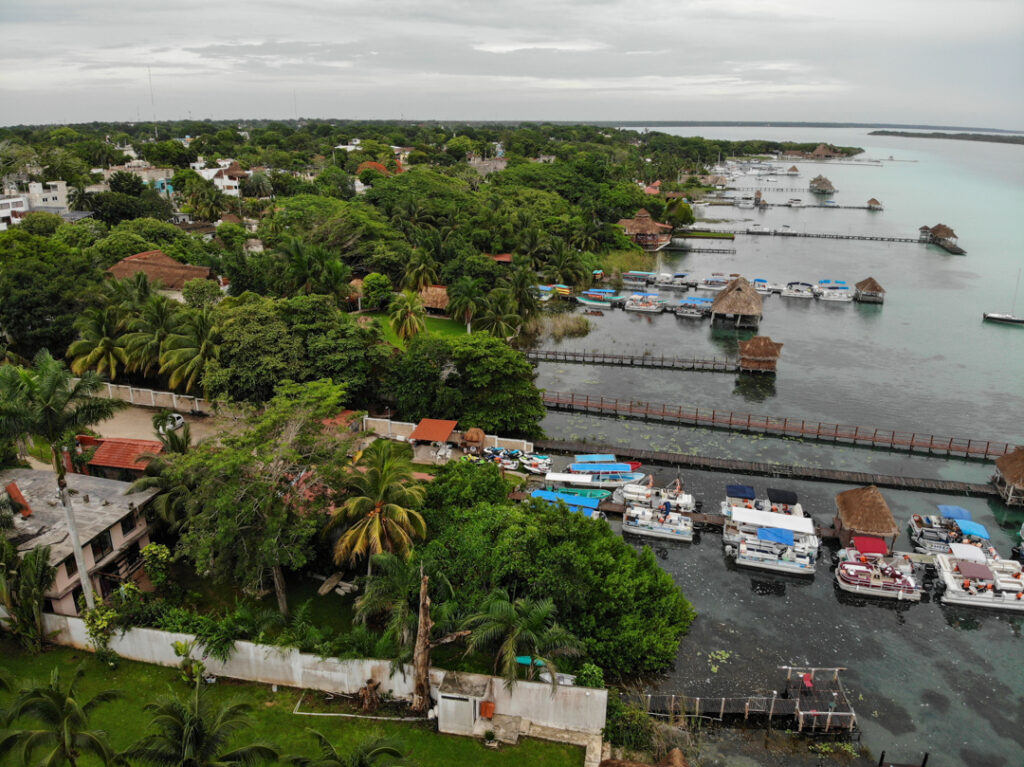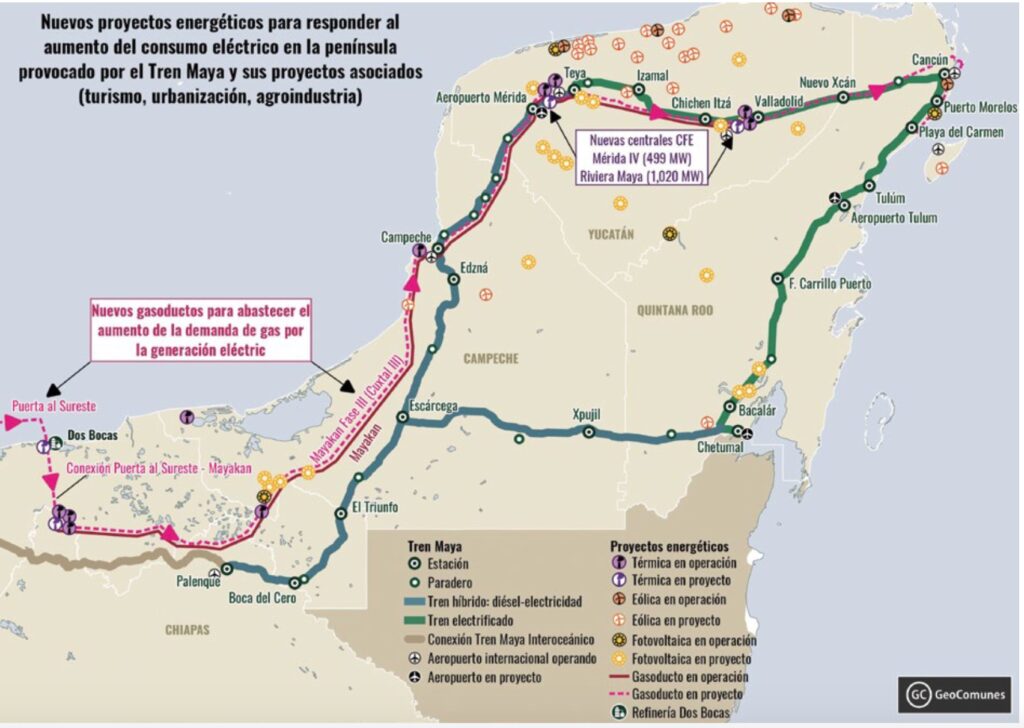Cover image: Hotel construction inside the Calakmul Biosphere Reserve in Campeche. Photo: Santiago Navarro F
The Maya Train is a central part of the territorial reorganization being carried out in the Yucatán Peninsula, in the southeast of Mexico, by the government of Andrés Manuel López Obrador. The train will cause an increase in electricity consumption in the region, says the GeoComunes collective in the report, Reestructuración Energética en México: subordinación territorial en el noroeste y sureste de México.
According to estimates from the Program for the Development of the National Electric System (PRODESEN 2022-2037), the region will have the highest increase in electricity consumption in the next 15 years (60% accumulated, passing 15,397 GWh to 24,368 GWh).
The section of the train between Mérida and Chetumal, which spans 690 kilometers, will be powered by electricity, representing 44% of the complete route. The rest will be hybrid, powered by both diesel and electricity. To energize this train, 53 electricity infrastructure projects have been announced: 43 power plants and 10 new medium tension transmission lines that total 556 kilometers.
The Maya Train Project

Machines of military engineers advance in the construction of Section 6 of the Maya Train. Photo: Renata Bessi
The Maya Train consists of the modernization and expansion of around 550 kilometers of the existing train lines (from Palenque to Valladolid), the construction of around 1,000 kilometers of a new line (Valladolid-Cancún-Riviera Maya-Chetumal-Escárcega), and the development of 21 train stations and 13 stops.
The project is also foreseen to include the expansion of industrial-extractive industries which require significant amounts of electricity and water. For example, the study mentions the beer company Heineken, which in September of 2023 announced the construction of what will be their eighth beer factory in Mexico, this one located in the municipality of Kanasín, Yucatán. It will move its supplies and products via the Maya Train and the Progreso Port.
The Maya Train will also encourage tourism and real estate expansion in the region. On the one hand, the study points out that it will offer new transportation infrastructure—trains and new airports in Tulum and Mérida—that will transport great numbers of tourists to already saturated areas like Cancún, Playa del Carmen, Tulum, and Mérida. On the other hand, it will permit the expansion of mass tourism and real estate related projects into new territories, as is happening in Bacalar and Valladolid where a new project is being developed by the company, Xcaret, and toward the Calakmul area.
You might be interested in- Bacalar: Those Left Behind and Forgotten by the Dispossession of the Maya Train
Today, most of the energy consumption in the peninsula is already destined for tourist cities. Between only six municipalities that concentrate tourism in Quintana Roo—Benito Juárez, Solidaridad, Puerto Morelos, Tulum, Islas Mujeres, and Cozumel—in 2022, they used 45% of the total electricity consumption in the 128 municipalities that make up the Yucatán Peninsula.
The GeoComunes collective warns in their investigation that the high consumption of electricity in tourist zones and large cities causes inequality in access to electricity.

Boats in the vicinity of the Bacalar Lagoon. Photo: Aldo Santiago
According to data from INEGI’s Census of Population and Housing, in 2020, there were still 14,270 homes lacking electricity in the peninsula, principally concentrated in the states of Quintana Roo (42%) and Yucatán (34%). “While these just over 14,000 homes represent barely 1% of those existing in the peninsula, their location shows that the lack of access is concentrated in the municipalities with greatest consumption.”
Expanding Energy
Most of the peninsula’s current electricity capacity is sustained by fossil-fuel power plants, according to the study of GeoComunes. These plants represent 80% of the capacity, while the rest of the capacity derives from four solar farms and three wind farms, located principally in the state of Yucatán.
In the Yucatán Peninsula there exists 42 power plants in operation that generate a total capacity of 2,933 MW, distributed principally between the states of Yucatán (1,842 MW) and Campeche (732 MW), while Quintana Roo contains only 12% of the capacity in the peninsula (359 MW).
In Yucatán, for the expansion of production, there are four plants in construction. With the new plants it will increase the capacity in the region up to 5,511 MW.
GeoComunes mapped another 22 power plants that already have permits from the Energy Regulation Commission (CRE) and that, if built, would add a total of 1,923 MW of capacity. There exist another 12 power plant projects that still don’t have permits from the CRE, but already have Environmental Impact Reports authorized or currently being evaluated. If built, these 12 plants would add another 1,465 MW of capacity.
As a whole, the majority of these 34 plants are planned to be constructed in the state of Yucatán (19 power plants), the state which concentrates 46% of the projected capacity, while the remaining 41% is in Campeche, and just 13% in Quintana Roo. In terms of technology, the 34 projected power plants are of two technologies: wind (1,627 MW) and solar (1,761 MW).
In addition, is the construction of new gas pipelines to supply the new power plants, hotel zones, and possible maritime hydrocarbon exportations.

Map of energy infrastructure in the Yucatán Peninsula. Source: GeoComunes
“There is no doubt that this is a process of territorial reorganization that will facilitate a new expansion of tourism, which for decades has generated dispossession, speculation, and privatization of ejido and communal lands, commodification and consumption of natural resources (water, land, biodiversity, Maya culture, etc.) and increased militarization and violence,” explains the collective in their study.
The investigation Reestructuración Energética en México: subordinación territorial en el noroeste y Sureste de México, carried out by the GeoComunes collective, also mapped the energy reorganization in the northeast of Mexico and in the Isthmus of Tehuantepec, in the states of Veracruz and Oaxaca.


